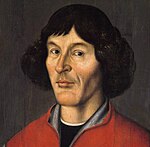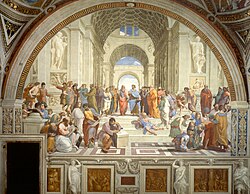| Revision as of 00:47, 21 March 2006 editPiotrus (talk | contribs)Autopatrolled, Event coordinators, Extended confirmed users, File movers, Pending changes reviewers, Rollbackers286,332 edits →Overview: several Google Print references for your reading pleasure← Previous edit | Revision as of 15:22, 22 March 2006 edit undoGhirlandajo (talk | contribs)Autopatrolled, Extended confirmed users, Pending changes reviewers89,661 edits edits Piotrus-styleNext edit → | ||
| Line 1: | Line 1: | ||
| {{Culture of Poland}} | {{Culture of Poland}} | ||
| The '''Renaissance in Poland''' (Polish: ''Odrodzenie'') lasted from the late ] to the late ] and was likely the ] of ]. The ] (from 1569 known as the ]), ruled by the ], actively participated in the European ]. A century without major wars - only conflicts on the sparsely populated eastern and southern borders - allowed the multinational Polish entity to experience a significant period of cultural growth. The ] spread peacefully throughout the country (giving the rise to the ]), living conditions improved significantly, cities grew, and exports of agricultural goods enriched the population, especially the nobility (]) who gained the dominant hand in the ] (]). | The '''Renaissance in Poland''' (Polish: ''Odrodzenie'') lasted from the late ] to the late ]{{fact}} and was likely{{fact}} the ]{{fact}} of ]{{fact}}. The ] (from 1569 known {{fact}}as the ]), ruled by the ]{{fact}}, actively participated in the European ]{{fact}}. A century without major wars - only conflicts on the sparsely populated eastern and southern borders {{fact}}- allowed the multinational{{fact}} Polish entity to experience a significant period of cultural growth{{fact}}. The ] spread peacefully{{fact}} throughout the country (giving the rise to the ]{{fact}}), living conditions improved significantly{{fact}}, cities grew{{fact}}, and exports of agricultural goods enriched the population{{fact}}, especially the nobility (]){{fact}} who gained the dominant hand in the ] (]){{fact}}. | ||
| == Overview == | == Overview == | ||
Revision as of 15:22, 22 March 2006
| Part of a series on the |
| Culture of Poland |
|---|
 |
| History |
| People |
| Languages |
| Traditions |
| Mythology |
| Cuisine |
| Festivals |
| Religion |
| Art |
| Literature |
| Music and performing arts |
| Media |
| Sport |
| Monuments |
| Symbols |
The Renaissance in Poland (Polish: Odrodzenie) lasted from the late 15th century to the late 16th century and was likely the golden age of Polish culture. The Kingdom of Poland (from 1569 known as the Polish-Lithuanian Commonwealth), ruled by the Jagiellon dynasty, actively participated in the European Renaissance. A century without major wars - only conflicts on the sparsely populated eastern and southern borders - allowed the multinational Polish entity to experience a significant period of cultural growth. The Reformation spread peacefully throughout the country (giving the rise to the Polish Brethren), living conditions improved significantly, cities grew, and exports of agricultural goods enriched the population, especially the nobility (szlachta) who gained the dominant hand in the political system (Golden Freedom).
Overview
The Renaissance, whose influence originated in Italy, started spreading in Poland in the 15th and 16th century. This was a result of Italian artists (Francesco Florentino, Bartholommeo Berecci, Santi Gucci, Mateo Gucci, Bernardo Morando, Giovanni Baptista di Quadro, etc.), merchants (Boners, Montelupi's ) and thinkers (Filip Callimachus) who had come to Poland since the late 15th. Most of them came to Cracow, the Polish capital until 1611.

The Renaissance belief in the dignity of man and power of his reason found a receptive ground in Poland. Many works were translated into Polish and Latin from classical Latin, Greek and Hebrew, as well as contemporary languages like Italian. Cracow Academy, one of the world's oldest universities, enjoyed it's Golden Era between 1500 and 1535, attracting 3215 students in the first decade of the 16th century - a record not surpassed until the late 18th century. The period of Polish renaissance, supportive of intellectual pursuits, produced many outstanding scientists and artists. Among them were Nicholaus Copernicus who in his De revolutionibus orbium coelestium developed the heliocentric theory of the universe, Maciej of Miechów, author of Tractatus de duabus Sarmatis..., the first accurate geographical and ethnographical description of Eastern Europe, Bernard Wapowski, a cartographer whose maps of Eastern Europe appeared in Ptolemy's Geography, Marcin Kromer who in his De origine et rebus gestis Polonorum libri... described both the history and geography of Poland, Andrzej Frycz Modrzewski, a philosopher who advanced novel political and social theories concerning the whole state, Mikołaj Rej who has popularized the use of Polish language in poetry, and Jan Kochanowski who perfected Polish poetic language and became recognized as the most eminent Slavic poet until the beginning of the 19th century.

Young Poles, especially sons of nobility, educated in a network of more then 2500 parish schools, many gymnasium and several academies often travelled abroad to complete their education. Members of Polish intellectual elite, like Andrzej Frycz Modrzewski, Jan Dantyszek or Jan Łaski maintained contacts with leading European luminaries, including Thomas Moore, Erasmus and Philip Melanchthon. Through this exchange of ideas Poland not only participated in major scientific and cultural developments also propagated Western heritage (for example, printing, Latin language) and art (lke syllabic versification in poetry)among East Slavic nations, especially in Belorussia and Ukraine (through Kyiv-Mohyla Academy), from where it was transmitted to Russia, which was increasing its ties with Europe in the aftermath of the Mongol invasion of Rus. The first four printed Cyrillic books in the world were published in Cracow, in 1491.
Incentives for development of art and architecture were many. King Zygmunt the Old, crowned in 1507, was a sponsor of many artists, and launched an ambitious project - under Florence architect Bartolommeo Berrecci - of transforming the ancient residence of the Polish kings, the Wawel Castle, into a modern Renaissance residence. Zygmunt's zeal for Renaissance was matched not only by his son, Zygmunt II August, but by many magnates and wealthy burghers who were also eager to display their artistic tastes and patronage. In 1578, chancellor Jan Zamoyski conceived a bold plan of building the ideal Renaissance city, and he sponsored the creation of Zamość, which quickly became an important administrative, commercial and educational city in Renaissance Poland. The main beneficiaries of Renaissance art were the two largest contemporary cities - Cracow (which attracted many Italian architects) and Gdańsk (which attracted mostly architects from Germany and the Netherlands) - but many other cities also spotted Renaissance buildings.

Renaissance painting was introduced in Poland by many immigrant artists, like Hans Dürer, Hans Suss and Lucas Cranach, and practicised by such local painters as Marcin Krober (a court painter of king Stefan Batory). The portraitists left behind a splendid pictorial gallery of the noble and the wealthy, capturing characteristic features and social position of each person.
The centre of musical culture was the royal residence at Cracow, where kings surrounded themselves with foreign and local composers and musicians. The finest works of the period include vocal and instrumental compositions, dances, organ and polyphonic music as well as solemn oratorios and masses. Especially popular were compositions for organ and the lute. The Tablature, compiled in 1540 b Jan of Lublin, was an extensive collection of all known European organ compositions. Mikołaj Gomółka was the author of musical rendition of Kochanowski's poems. The most famous Polish composer was Wacław z Szamotuł, recognized as one of the outstanding Renaissance composers.
The first printing press was set up in Cracow in 1473 by Kasper Straube from Bavaria. It is estimated that between 1561 and 1600 seventeen printing houses in Poland published over 120 titles per year, with the average edition size of 500 copies. The first complete translation of the Bible into Polish was done in 1561 by Jan Leopolita. Around that time the first Polish orthography dictionary was published (by Stanisław Murzynowski in 1551); grammar books and dictionaries also proliferated. Polish renaissance was bi-lingual, with the szlachta's speech being a mixture of Polish and Latin, and various authors oscillating between Polish, Latin and a mixture of those two languages.
The general tone of Polish literature was set by the nobility, who propagated their own ideals of material and spiritual values. Thus poems extolled the virtue of manor life and importance of agriculture: for example Rej celebrated life and occupation of country's noble, while Kochanowski wrote about the pleasures and beauty of country's lives and nature. Literary forms varied, from ode, pastorals and sonnets to elegy, satire and romance.
Scholars of Polish Renaissance
| Renaissance |
|---|
 The School of Athens (1509–1511) by Raphael The School of Athens (1509–1511) by Raphael |
| Aspects |
| Regions |
| History and study |
- Jan Łaski (John Lasco), evangelical reformer
- Maciej of Miechów (Maciej Miechowita), writer, university teacher
- Nicholas Copernicus, astronomer
- Marcin Kromer, writer, geographer
- Andrzej Frycz Modrzewski, writer, philosopher
- Piotr Skarga, Jesuit, political reformer
Artists of Polish Renaissance
- Mikołaj Rej, poet
- Jan Kochanowski, poet
- Szymon Szymonowic, poet
- Mikołaj Sęp Szarzyński, poet
- Łukasz Górnicki, writer
- Jan Sacranus, writer
- Andrzej Krzycki, poet
- Johannes Dantiscus, poet
- Wacław z Szamotuł, composer
- Mikołaj Gomółka, composer, singer
- Marcin Krober, painter
Immigrants:
- Hans Dürer
- Hans Suss
- Lucas Cranach
- Mateo Gucci
- Santi Gucci
- Georg Pencz
- Bartholommeo Berecci
- Bernardo Morando
Polish renaissance buildings gallery
-
 Kraków
Kraków
-
 Kraków
Kraków
-
 Kraków
Kraków
-
 Gdańsk
Gdańsk
-
 Poznań
Poznań
-
 Zamość
Zamość
-
 Baranów Sandomierski
Baranów Sandomierski
-
 Kazimierz Dolny
Kazimierz Dolny
-
 Janowiec
Janowiec
-
 Nowy Wiśnicz
Nowy Wiśnicz
-
 Ogrodzieniec
Ogrodzieniec
-
 Golub-Dobrzyń
Golub-Dobrzyń
-
 Warsaw
Warsaw
References
- Michael J. Mikoś, Polish Renaissance Literature: An Anthology. Ed. Michael J. Mikoś. Columbus, Ohio/Bloomington, Indiana: Slavica Publishers. 1995. ISBN 0893572578 (contains short bio and "Satire III: On Burdens and Oppressions of Peasants in Poland.") First chapters online